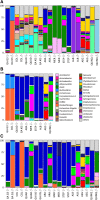Estimating bacteria diversity in different organs of nine species of mosquito by next generation sequencing
- PMID: 30286722
- PMCID: PMC6172810
- DOI: 10.1186/s12866-018-1266-9
Estimating bacteria diversity in different organs of nine species of mosquito by next generation sequencing
Abstract
Background: Symbiosis in insects is accumulating significant amount of studies: the description of a wide array of mutualistic associations across the evolutionary history of insects suggests that resident microbiota acts as a driving force by affecting several aspects of hosts biology. Among arthropods, mosquito midgut microbiota has been largely investigated, providing crucial insights on the role and implications of host-symbiont relationships. However, limited amount of studies addressed their efforts on the investigation of microbiota colonizing salivary glands and reproductive tracts, crucial organs for pathogen invasion and vertical transmission of symbiotic microorganisms. Using 16S rRNA gene sequencing-based approach, we analysed the microbiota of gut, salivary glands and reproductive tracts of several mosquito species, representing some of the main vectors of diseases, aiming at describing the dynamics of bacterial communities within the individual.
Results: We identified a shared core microbiota between different mosquito species, although interesting inter- and intra-species differences were detected. Additionally, our results showed deep divergences between genera, underlining microbiota specificity and adaptation to their host.
Conclusions: The comprehensive landscape of the bacterial microbiota components may ultimately provide crucial insights and novel targets for possible application of symbionts in innovative strategies for the control of vector borne diseases, globally named Symbiotic Control (SC), and suggesting that the holobiont of different mosquito species may significantly vary. Moreover, mosquito species are characterized by distinctive microbiota in different organs, likely reflecting different functions and/or adaptation processes.
Keywords: Metagenomics; Mosquitoes; Symbionts.
Conflict of interest statement
Ethics approval and consent to participate
Research carried out on invertebrate such as mosquitoes do not require a specific permit according to the directive 2010/63/EUof the European Parliament and of the Council on the protection of animals used for scientific purposes.
Consent for publication
Competing interests
The authors declare that they have no competing interest.
Publisher’s Note
Springer Nature remains neutral with regard to jurisdictional claims in published maps and institutional affiliations.
Figures




Similar articles
-
Deep sequencing reveals extensive variation in the gut microbiota of wild mosquitoes from Kenya.Mol Ecol. 2012 Oct;21(20):5138-50. doi: 10.1111/j.1365-294X.2012.05759.x. Epub 2012 Sep 18. Mol Ecol. 2012. PMID: 22988916
-
Mosquito microbiota cluster by host sampling location.Parasit Vectors. 2018 Aug 14;11(1):468. doi: 10.1186/s13071-018-3036-9. Parasit Vectors. 2018. PMID: 30107817 Free PMC article.
-
Bacterial diversity analysis of larvae and adult midgut microflora using culture-dependent and culture-independent methods in lab-reared and field-collected Anopheles stephensi-an Asian malarial vector.BMC Microbiol. 2009 May 19;9:96. doi: 10.1186/1471-2180-9-96. BMC Microbiol. 2009. PMID: 19450290 Free PMC article.
-
Diversity and function of bacterial microbiota in the mosquito holobiont.Parasit Vectors. 2013 May 20;6:146. doi: 10.1186/1756-3305-6-146. Parasit Vectors. 2013. PMID: 23688194 Free PMC article. Review.
-
The mosquito holobiont: fresh insight into mosquito-microbiota interactions.Microbiome. 2018 Mar 20;6(1):49. doi: 10.1186/s40168-018-0435-2. Microbiome. 2018. PMID: 29554951 Free PMC article. Review.
Cited by
-
Sugarcane Wax Metabolites and Their Toxicity to Silkworms.Life (Basel). 2023 Jan 19;13(2):286. doi: 10.3390/life13020286. Life (Basel). 2023. PMID: 36836643 Free PMC article.
-
The dynamic gut microbiota of zoophilic members of the Anopheles gambiae complex (Diptera: Culicidae).Sci Rep. 2022 Jan 27;12(1):1495. doi: 10.1038/s41598-022-05437-y. Sci Rep. 2022. PMID: 35087127 Free PMC article.
-
Three species of axenic mosquito larvae recruit a shared core of bacteria in a common garden experiment.Appl Environ Microbiol. 2023 Sep 28;89(9):e0077823. doi: 10.1128/aem.00778-23. Epub 2023 Sep 8. Appl Environ Microbiol. 2023. PMID: 37681948 Free PMC article.
-
Bacterial communities of Aedes aegypti mosquitoes differ between crop and midgut tissues.PLoS Negl Trop Dis. 2023 Mar 29;17(3):e0011218. doi: 10.1371/journal.pntd.0011218. eCollection 2023 Mar. PLoS Negl Trop Dis. 2023. PMID: 36989328 Free PMC article.
-
Re-Analysis of 16S rRNA Gene Sequence Data Sets Uncovers Disparate Laboratory-Specific Microbiomes Associated with the Yellow Fever Mosquito (Aedes aegypti).Microb Ecol. 2022 Jan;83(1):167-181. doi: 10.1007/s00248-021-01739-2. Epub 2021 Apr 2. Microb Ecol. 2022. PMID: 33797563
References
Publication types
MeSH terms
Substances
LinkOut - more resources
Full Text Sources
Medical

